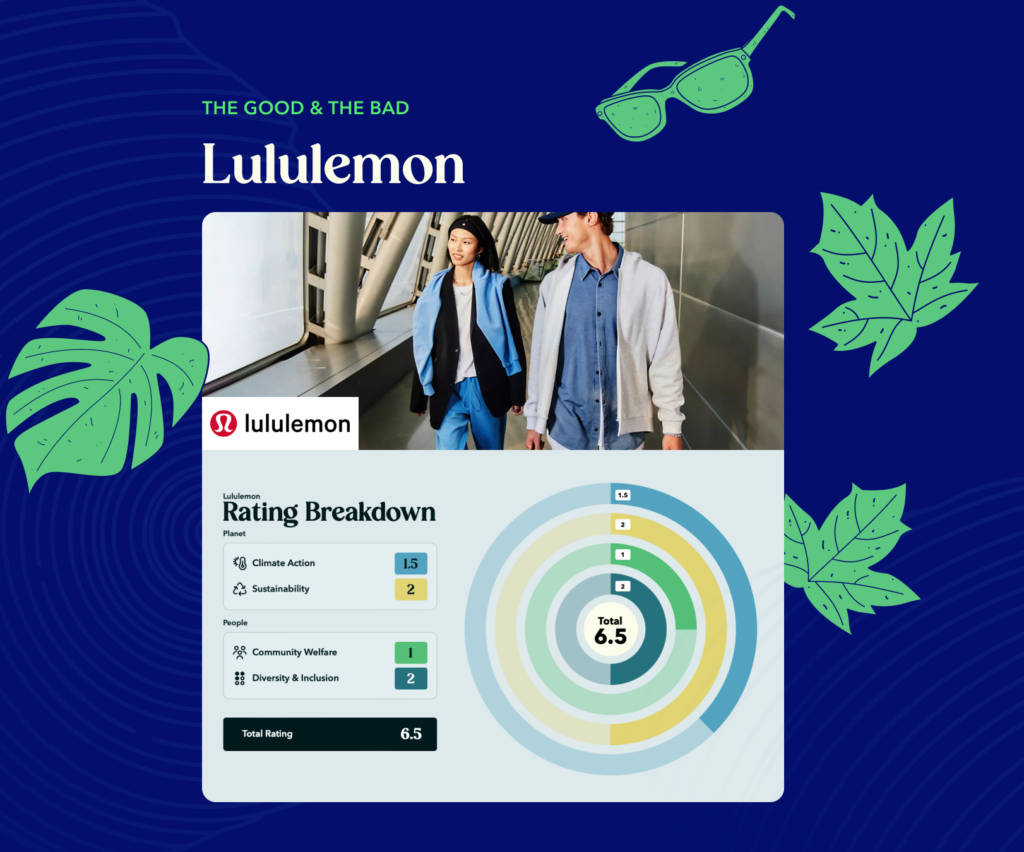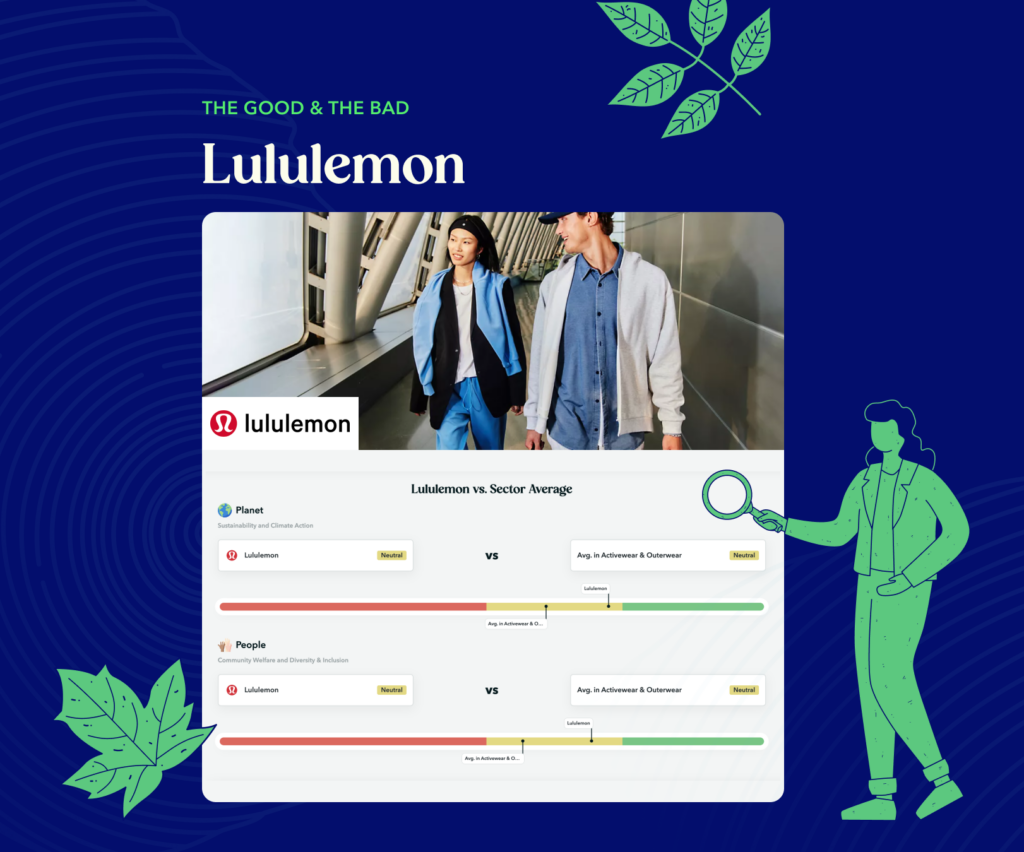Lululemon’s Sustainability: The Good & The Bad
We dove into the numbers here at Karma Wallet, and found Lululemon scoring a 6.5/16. That’s way above the activewear industry’s average of a mere 2.64/16. So, what gives? Let’s unpack the story behind the score and see just how Lululemon measures up in the grand scheme of sustainability.
February 6, 2024

Lululemon has woven the mantra of ‘Be Human, Be Well, Be Planet‘ into the fabric of its brand identity. With initiatives spanning from employee empowerment and equitable wellness access to ambitious climate action and circularity, the brand sets a high bar. But as we peel back the layers of these eco-promises, a question bubbles up:
How well do Lululemon’s actions mirror its aspirations?
We dove into the numbers here at Karma Wallet, and found Lululemon scoring a 6.5/16. That’s way above the activewear industry’s average of a mere 2.64/16. So, what gives? Let’s unpack the story behind the score and see just how Lululemon measures up in the grand scheme of sustainability.

The Good:
#1 The Push Towards Circularity
Lululemon is on the brink of revolutionizing activewear with its bold stride towards circularity. By 2025, they aim to redefine the lifecycle of sportswear through a model that encourages customers to resell, recycle, and repair their gear [Lululemon]. This initiative is more than a nod to environmental stewardship; it’s a commitment to reducing the ecological footprint of their products and championing sustainable fashion practices. With pilot projects already rolling out in North America, Lululemon is laying the groundwork for a global shift towards more sustainable consumption patterns, signaling a pivotal change in how we engage with activewear.
Their circular guest model isn’t just talk. Lululemon is actively engaging designers and customers in this eco-friendly journey, providing training tools and innovation labs to create products designed for longevity and minimal impact [GreenMatters] This approach aligns with their broader goal of ‘transitioning towards a circular economy’, where every product is crafted with its end-of-life in mind [Lululemon]. Sounds like a pretty bright future. By offering new models for product reuse and recycling, they are not only extending the life of their products but also setting a new standard for the industry.
#2 Flipping the Eco-Switch:
Lululemon gets big props here for successfully transitioning to 100% renewable energy in 2021 [Fashion United]. No small feat. They’ve leveled up their eco-game by partnering with Enel Green Power North America, striking a virtual power purchase agreement that lights up Lululemon’s entire US footprint—360 stores, six offices, and five distribution centers—with clean, green energy.
This partnership not only illuminates their commitment to slashing carbon emissions but also propels them towards their ambitious sustainability goals [Fashion United]. Beyond just powering up responsibly, Lululemon’s continuous innovation in product and material sustainability is setting new industry benchmarks, proving that high-performance activewear and environmental stewardship can go hand in hand [2022 Impact Report].
#3 From Plants to Pants:
In a bold move, Lululemon aims to transform its material portfolio by 2030, prioritizing recycled, renewable, and responsibly sourced options [The Wall Street Journal]. Notably, their venture into plant-based nylon for their product lines marks a significant step towards reducing dependency on fossil fuels.
In an enlightening chat with The Wall Street Journal, Esther Speck, Lululemon’s Senior Vice President of Global Sustainable Business and Impact, revealed, ‘We’re in the midst of calculating the emission reductions from our switch to biomaterials. Preliminary estimates are promising, indicating that using plant-based nylon could potentially cut our production emissions by nearly half compared to traditional petroleum-based fabrics.”

The Bad:
#1 Emissions Escalations:
Lululemon’s ‘Be Planet’ ambition is all about slashing that carbon footprint, but here’s the twist: the real picture might not be as green as we hoped. Stand.earth dropped some numbers saying Lululemon’s supply chain emissions could end up being nine times what they’re aiming for by 2030, even though they’ve pledged to cut down emissions intensity by 60%. Kind of a big gap, right? And to paint it even clearer, the Vancouver Sun pointed out that in 2022, Lululemon’s carbon output was like having 208,000 cars cruising around for a year, doubling their emissions from back in 2018.
#2 The Coal Conundrum:
Alright, let’s peel the eco-onion on Lululemon’s ‘Be Human’ mantra. They’re all about championing safe workspaces and singing the praises of wellness, according to their 2022 Impact Report Sounds noble, right? But dig a bit deeper, and you hit a coal seam. Stand.earth shines a light on a not-so-pretty picture: Lululemon’s emissions went through the roof, spiking by 83% between 2019 and 2021, with coal burning brightly in their supply chain. Ouch. That’s not just warming the planet; it’s putting the people making those sleek leggings at risk, especially in places like Vietnam.
So, here’s the rub: Lululemon’s talk on wellness and their eco-footprint? They’re not walking in the same yoga pants. Breaking up with coal isn’t just a good move; it’s essential for Lululemon to live up to their own ‘Be Human’ hype and look out for both the planet and their people.
#3 Dropping the Ball on Investments:
Let’s dive into the eco-finance pool. Lululemon’s chipping in with a $10 million pledge to sustainability. Sounds pretty hefty, doesn’t it? But when you zoom out to their $8.1 billion revenue in 2022, courtesy of a heads-up from Canada’s National Observer, that contribution suddenly looks more like a drop in the ocean – yup, just 0.12% of their total earnings. It’s like comparing a quick stretch to a full-on yoga session. With that kind of dough rolling in, couldn’t they bend a little further for the planet?
Lululemon’s Sustainability
While Lululemon navigates its eco-journey, what actual progress they are making remains under scrutiny. The path to fulfilling these ambitions is complex but not insurmountable.
As we wrap up our deep dive into their sustainability efforts, it’s impossible to ignore the larger picture the United Nations painted for us back in 2019. The fashion industry finds itself at a crossroads, consuming a staggering 8% to 10% of the world’s greenhouse gas emissions. This figure eclipses the combined toll of aviation and shipping, largely due to the relentless use of fossil fuels in fabric production. Without a significant shift in our approach, we’re on track to witness a 50% increase in these emissions by 2030 [The Wall Street Journal].
Lululemon’s journey toward sustainability, while worthy of acknowledgment, highlights a broader issue: it’s simply not enough. Their initiatives represent progress, yet the scale and speed pale in comparison to the urgency and magnitude of the challenge at hand. The discrepancy between aspirations and tangible outcomes is both wide and deep.
So, we turn to you, our readers, to join this critical conversation: How do we measure the sincerity and impact of a brand’s sustainability efforts? What benchmarks should companies like Lululemon aim for to ensure that their journey towards environmental responsibility moves beyond aspirations to effect real, measurable change?
We rate Lululemon’s sustainability 6.5/16, with most of their points coming from Diversity & Inclusion and Climate Action Initiatives. Check out their Karma Wallet Company Report Card below!

















